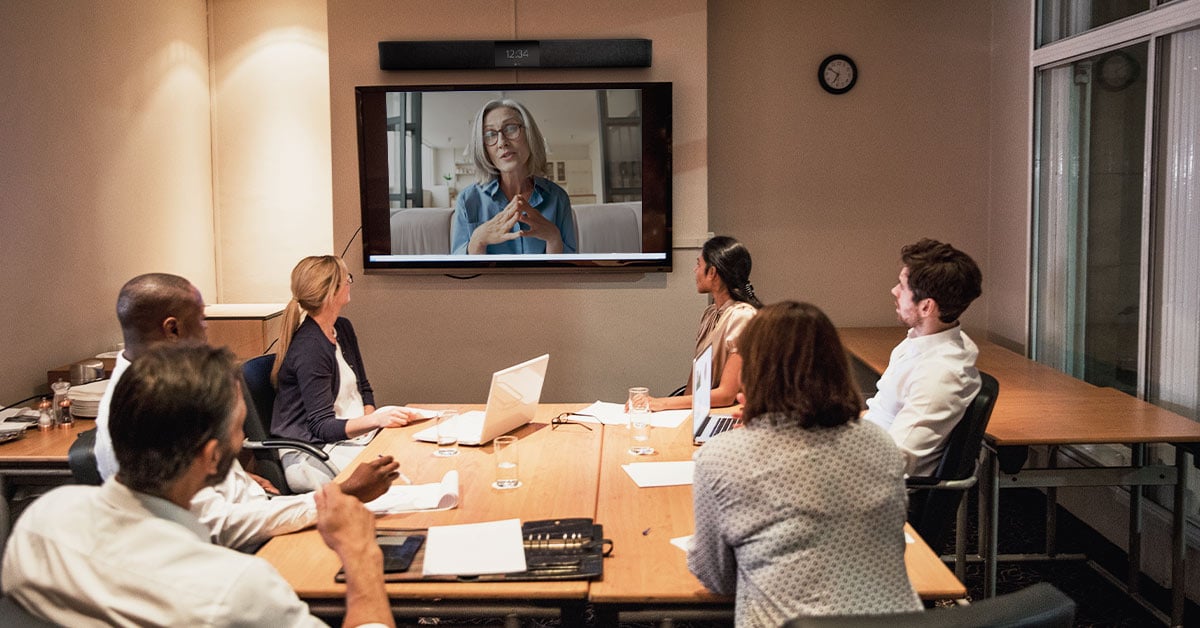17 ways to improve hybrid meetings for your teams – starting today

Posted by Tricia Whenham on Dec 1, 2021 6:00:00 AM
The best of both worlds. Who wouldn’t want that?
As organizations plan for the future of work, forcing employees to choose between full-time in the office and working from home just doesn’t seem like the way forward. Hybrid work offers you the flexibility to meet individual needs – leading to happier, more productive team members.
For this vision to become a reality, everyone needs to work together. That’s where the hybrid meeting comes in. But running an effective hybrid meeting isn’t as easy as it looks. If these meetings fall flat – derailed by technical issues or marred by a lack of remote participation and engagement – your hybrid work plan is in jeopardy.
Hybrid meetings can be very effective and productive – and we can learn to master them just as we learned to master fully remote meetings. But they do require a somewhat different approach. Whether you’re new to hybrid meetings or just looking for a tune-up, here are 17 tips to stay on track.
1. Start on time
Meetings that consistently begin a few minutes late are frustrating enough for those in the office. But asking remote people to wait on a Microsoft® Teams or Zoom call is even worse. Create a culture in your organization of on-time meetings so remote people don’t feel like their time is devalued.
2. Connect immediately
Similarly, don’t wait until everyone is in the meeting room to start Teams or Zoom. Welcoming remote people into the in-room chatter that kicks off a meeting can help them feel like a part of things, not like an afterthought. If you have a larger meeting, consider taking this further with what these facilitators have dubbed Zoom’s magic waiting room.
3. Try icebreakers
Icebreakers don’t always have the best reputation, especially since some drag on or put people way out of their comfort zone. But quick, low-stakes icebreakers can encourage participation from everyone from the start, which often leads to a higher energy meeting. Here are some to try.

4. Use a backchannel
A backchannel offers an alternative way to participate – without every comment needing to be spoken out loud. It’s a staple of remote meetings, with people naturally sharing ideas and asking questions right in the UC&C chat window. In a hybrid meeting, the backchannel can increase participation, especially from remote participants. Those in the room just need to use their phones or laptops to join in.
5. Choose an in-room facilitator
During a hybrid meeting, it can be easy for the conversation in the room to take off – with people at the other end of the conference call forgotten. Or a technical issue that affects remote people only goes unnoticed. Picking someone in the room to focus on the remote team members can help. Try rotating this job amongst team members so everyone becomes more attuned to the remote experience.
6. Ensure you have full-room mic pickup
Your meeting rooms need to deliver a remote audio experience that’s a close as possible to being in the room – it’s the only way to get full engagement. In practice, this means audio that doesn’t cut out when someone turns away from the mic or moves away from the table to show something on a display. You also need audio that can handle it when people talk at the same time or when a noisy HVAC system turns on. (Here’s how we can help.)
7. Let remote employees stay unmuted
It’s common for remote people to mute themselves when they’re not talking, to keep background noise at a minimum. But constant muting and unmuting can make participation feel unnatural. Equip remote people with quality headsets so they can stay unmuted most of the time and jump into conversations easily.

8. Consider your video tools
While clear audio is the number one priority in a hybrid meeting, video also helps bridge the gap between in-person and remote team members. Choose video options that let people see the entire room or that track whoever’s speaking. And make sure to ask remote people about their experience so you can adjust.
9. Put remote people on display
In hybrid meetings, out of sight too often means out of mind. Showing remote participants on a large display helps everyone remember they’re there. Keeping webcams on is ideal, so those in the room can read expressions and body language, but even just an avatar and name helps.
10. Develop clear cues
One of the hardest things about being remote in a hybrid meeting is breaking into the conversation. Consider coming up with clear signals that people in the room can watch for. It can be as simple as raising a hand – or using the raise hand icon in Teams or Zoom. And be sure to make explicit what the signals will be, so everyone in the room can be on the lookout for them.
11. Level the playing field
Don’t use any tool that doesn’t work equally well for everyone. For example, a sticky-note wall or whiteboard in the meeting room is rarely clear to remote participants. Instead, choose digital whiteboarding tools that everyone can see and use online. Polling apps can also be a useful addition in large hybrid meetings.
12. Invite participation
In a meeting room, it’s easy to unintentionally give precedence to the people who are there physically, not virtually. To avoid this, it helps for people in the room to directly ask remote participants for ideas and input. And if people are going around the table giving updates in turn, make sure that remote people aren’t always left for last.
13. Be strategic about silence
When we hear silence, it’s natural to want to jump in and fill it. But during hybrid meetings, silence is necessary to give remote people a chance to speak, especially if there are connection delays. When in doubt, let remote participants fill the silence first, as they’re the ones more likely to be talked over.
14. Eliminate the meeting after the meeting
How often does it happen – the meeting ends, and then the real problem solving happens on the way back to workstations. This habit can be incredibly damaging to hybrid teams, leaving remote people out of key decisions and information sharing. Avoid these side conversations as much as possible. And if they do spring up, reach out to remote people right away to loop them in on what was missed.
15. Experience it yourself
It’s easier to look out for remote team members if you’ve been there. In some hybrid organizations, everyone will get the chance to be remote regularly. But if yours has some people who never work remotely, make sure they get the chance to experience life from the other end of the Teams or Zoom call – even if it’s just them logging in from their desk.
16. Be transparent and deliberate
Great hybrid meetings – like all meetings – don’t happen without commitment. And just because people have been in a lot of fully remote meetings, it doesn’t mean that all those skills will automatically transfer over. It helps to involve everyone in determining what hybrid meetings should look and feel like – and then hold each other accountable if they’re falling short.
17. Ask for feedback
Even if you think you have hybrid meetings nailed, don’t get complacent. Ask for feedback periodically to make sure team members in your organization are still finding these meetings effective. It’s easier to make small adjustments regularly than wait till everything falls apart.

Posted by
Tricia Whenham
December 1, 2021

















